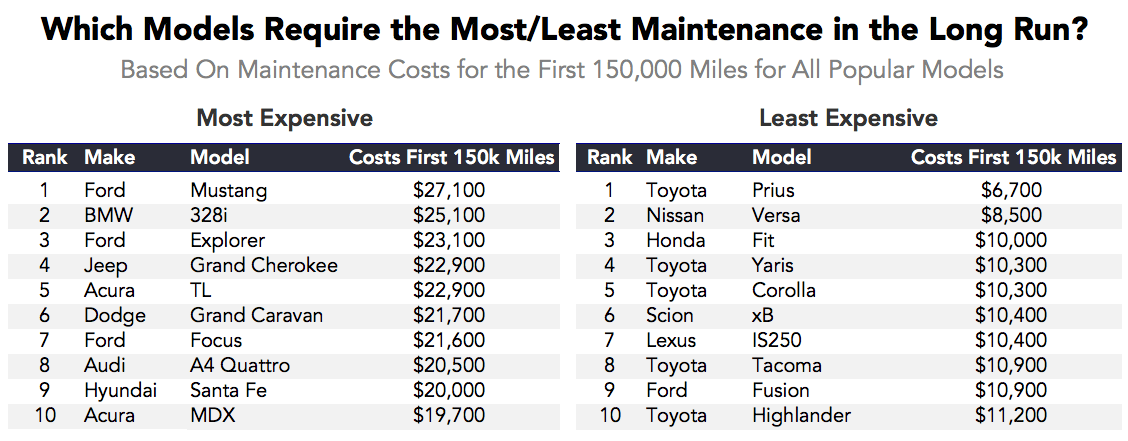This post is adapted from YourMechanic, a Priceonomics Data Studio customer. Does your company have interesting data? Become a Priceonomics customer.
***
The average American depends on a car for 37 miles of transportation per day. Commuters spend around one hour in their car every day. Long commutes can be a bummer, but breaking down is worse.
We wanted to know which cars can go the distance and which will leave drivers stranded on the side of the road. So we teamed up with YourMechanic, a Priceonomics customer that has a dataset that includes the make, model, and mileage of the cars it has serviced.
Previously, we used this data to explore how cars hold up as they age. For this article, we examined how cars stand up to usage. In other words, which cars have the least maintenance costs as the miles add up? We also looked at which types of maintenance become more common with increased mileage.
***
We began our analysis by asking how much more it costs to maintain the average car for the first 25,000 miles compared to the next 25,000 miles. (In order to estimate maintenance costs by distance, we took the total cost of maintenance for cars in this mileage category and divided it by the number of oil changes. Assuming 5,000 miles per oil change, this gives us the cost of maintenance required per mile).

Data source: YourMechanic
The average car costs $1,400 to maintain for the first 25,000 miles, and the costs increase from there. Costs increase dramatically until the 100,000 mile mark, and less intensely after 100,000 miles. A car’s maintenance costs may top out, or it could be that drivers scrap their cars once maintenance costs trump the car’s value.
Which types of cars are the cheapest to maintain? First, we looked at which makes (brands) are cheapest to maintain for the first 75,000 miles.

Data source: YourMechanic
There are few surprises here. Low-end carmakers such as Hyundai and Kia rank as the least expensive. On the other hand, premium models, such as Mercedes-Benz and BMW, are the most expensive. For the first 75,000 miles, these high-end makes are about three times as expensive to maintain than the least expensive options. Maintaining high-performance vehicles isn’t cheap.
But which makes stayed inexpensive with high mileage? We grouped the data by make and compared maintenance costs across the first 150,000 miles traveled.

Data source: YourMechanic
Cars that initially seem inexpensive don’t always remain a bargain. Low-end makes Hyundai and Kia require the least expensive maintenance for the first 75,000 miles, but drop to 6th and 9th place over 150,000 miles.
High-end makes such as Mercedes-Benz and BMW start out expensive (about $11,000 or more for the first 75,000 miles) and stay just about as expensive as mileage increases. Mid-range car brands are a mixed bag. Dodge drops from 16th to 22nd place due to maintenance costs rising with increased mileage, but Subaru moves from 5th place to 4th place. Subaru keep costs down even as miles accumulate.
Toyota (and its brand Scion) is the clear winner.
Beyond looking at the make of car, we were curious about which models have the most longevity. The following table shows the specific models that are most and least expensive over the first 75,000 miles. We list only the top ten most and least expensive because there are so many models.

Data source: YourMechanic
Toyota’s Prius, which costs only $2,800 in maintenance for the first 75,000 miles, is the clear winner. Nissan’s Versa and Chevrolet’s Tahoe also make strong showings. Overall, smaller cars from Honda, Hyundai, Nissan, and Toyota are quite inexpensive to maintain.
But which of these models remain a bargain as the odometer climbs from 75,000 to 150,000?

Data source: YourMechanic
Toyota’s Prius is the least expensive model to maintain at both low and high mileages; maintenance costs a meager $6,700 over 150,000 miles. The next best option, Nissan’s Versa, which costs an average of $8,500 in maintenance over $150,000 miles, still costs owners over 25% more than the Prius does.
The other high performers are mainly coupes and sedans. Yet Toyota gets its SUV (Highlander) and truck (Tacoma) on the list.
Which issues are most likely to affect these maintenance costs?
We looked at the most common issues and their probability of occurring. For example, if one out of ten cars gets its brake pads replaced between 25,000 and 30,000 miles, then cars of that mileage have a 10% chance of needing to replace their brake pads per 5,000 miles. Conversely, if one in four cars that has between 100,000 and 105,000 miles on its odometer gets its brake pads replaced, that same probability would be 25%.

Data source: YourMechanic
The most common issues are that the car won’t start or that the Check Engine Light is on. Brake pads, spark plugs, and batteries also require frequent repair.
Drivers need to check the engine light and deal with a car that refuses to start more often as their mileage increases. In contrast, problems with brake pads max out at 50,000 miles and spark plug issues max out at 100,000 miles. Drivers consistently deal with bad batteries for their car’s entire lifespan.
***
When buying a used car or maintaining a vehicle, consumers need to know which cars cost the least in maintenance as mileage increases. Factors like the state of the surrounding roads and owners’ maintenance habits affect these costs too.
Still, our analysis is a good guide to which cars stand up best to heavy usage. Some particular brands and models—like Toyota and its Prius—stand out as handling wear and tear particularly well. But with every car, as the miles add up, the odds that it won’t start at some point rise to 100%.
![]()
Note: If you’re a company that wants to work with Priceonomics to turn your data into great stories, learn more about the Priceonomics Data Studio.




